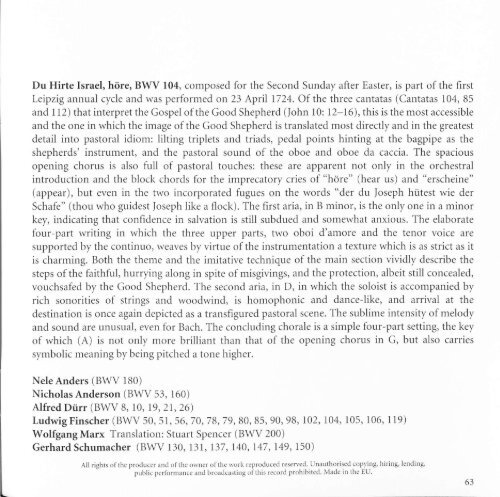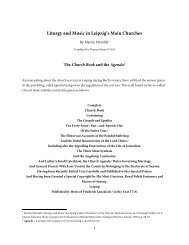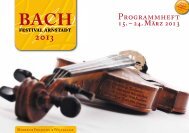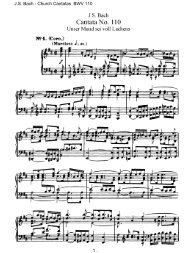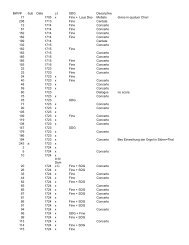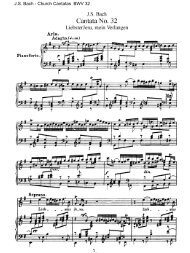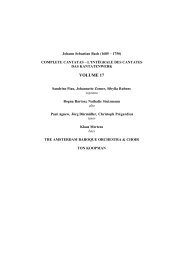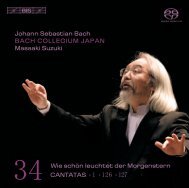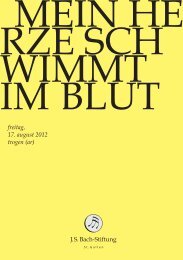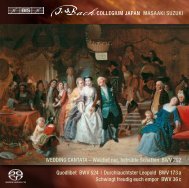Bach Cantatas, Vol. 2 - F. Werner (Erato 10-CD)
Bach Cantatas, Vol. 2 - F. Werner (Erato 10-CD)
Bach Cantatas, Vol. 2 - F. Werner (Erato 10-CD)
You also want an ePaper? Increase the reach of your titles
YUMPU automatically turns print PDFs into web optimized ePapers that Google loves.
Du Hirte Israel, höre, BWV <strong>10</strong>4, composed for the Second Sunday after Easter, is part of the first<br />
Leipzig annual cycle and was performed on 23 Aprll 1724. Of the three cantatas (<strong>Cantatas</strong> <strong>10</strong>4, 85<br />
and ll2) that interpret the Gospel of the Good Shepherd (lohn <strong>10</strong>: 12-16), this is the most accessible<br />
and the one in which the image of the Good Shepherd is translated most directly and in the greatest<br />
detail into pastoral idiom: lilting triplets and triads, pedal points hinting at the bagpipe as the<br />
shepherds' instrument, and the pastoral sound of the oboe and oboe da caccia. The spacious<br />
opening chorus is also full of pastoral touches: these are apparent not only in the orchestral<br />
introduction and the block chords for the imprecatory cries of "höre" (hear us) and "erscheine"<br />
(appear), but even in the two incorporated fugues on the words "der du Joseph hütest wie der<br />
Schafe" (thou who guidest loseph like a flock). The first aria, in B minor, is the only one in a minor<br />
key, indicating that confidence in salvation is still subdued and somewhat anxious. The elaborate<br />
four-part writing in which the three upper parts, two oboi d'amore and the tenor voice are<br />
supported by the continuo, weaves by virtue of the instrumentation a texture which is as strict as it<br />
is charming. Both the theme and the imitative technique of the main section vividly describe the<br />
steps of the faithful, hurrying along in spite of misgivings, and the protection, albeit still concealed,<br />
vouchsafed by the Good Shepherd. The second aria, in D, in which the soloist is accompanied by<br />
rich sonorities of strings and woodwind, is homophonic and dance-like, and arrival at the<br />
destination is once again depicted as a transfigured pastoral scene. The sublime intensity of melody<br />
and sound are unusual, even for <strong>Bach</strong>. The concluding chorale is a simple four-part setting, the key<br />
of which (A) is not only more brilliant than that of the opening chorus in G, but also carries<br />
symbolic meaning by being pitched a tone higher.<br />
Nele Anders (B\\1/ 180)<br />
Nicholas Anderson (BWV 53, 160)<br />
AlfredDürr (BVW 8, <strong>10</strong>, 19, 21,26)<br />
LudwigFinscher (B\AIV 50, 51, 56, 70,78,79,80, 85, 90, 98,<strong>10</strong>2,<strong>10</strong>4, <strong>10</strong>5, <strong>10</strong>6, 119)<br />
Wolfgang Marx Translation: Stuart Spencer (BWV 200)<br />
Gerhard Schumacher (BWV 130, l3l, 137, 140, 147, 149, 150)<br />
All rights ofthe producer and ofthe owner of the work reproduced reserved. Unauthorised copying, hiring, lending,<br />
public performance and broadcasting ofthis record prohibited. Made in the EU<br />
63


